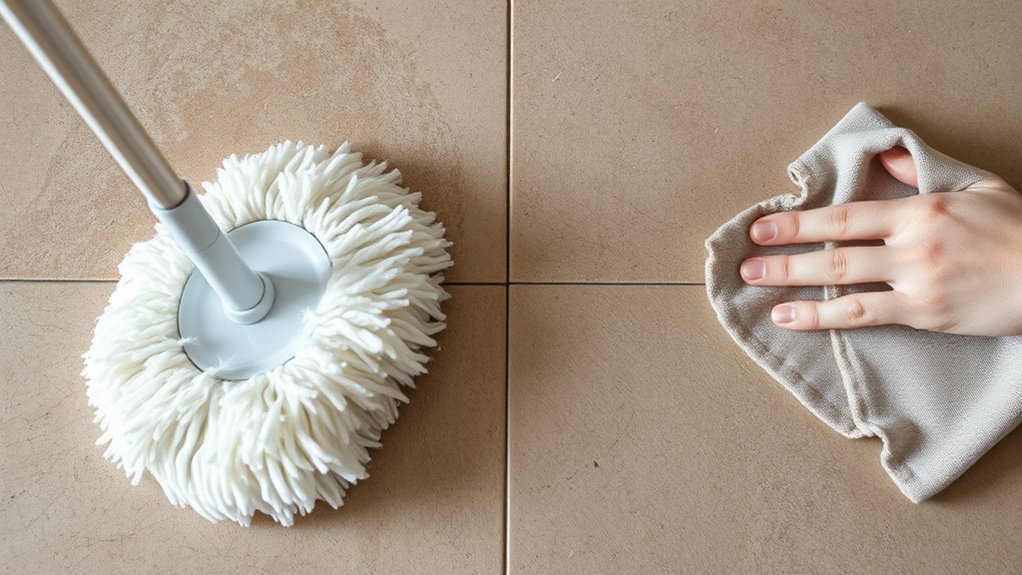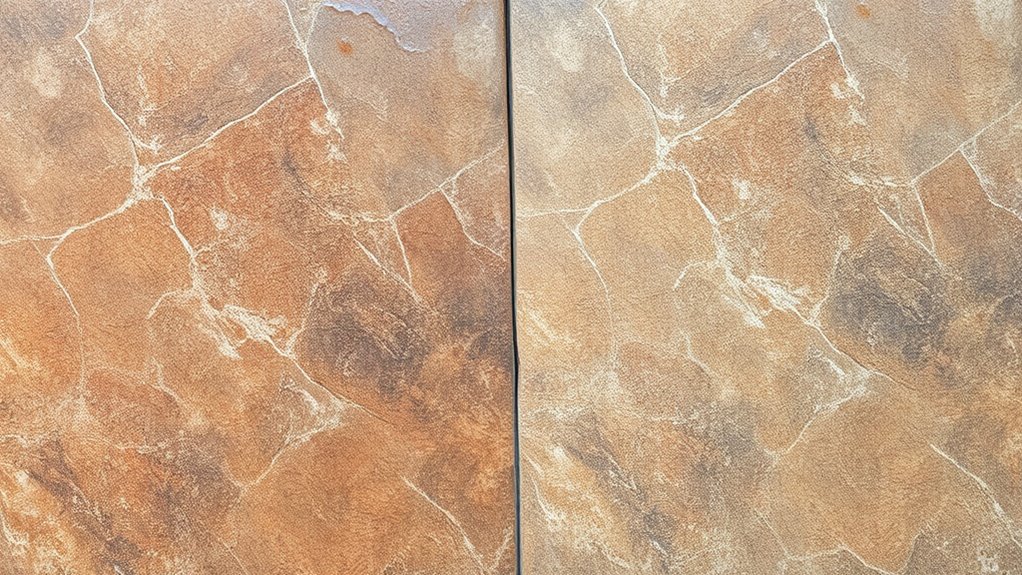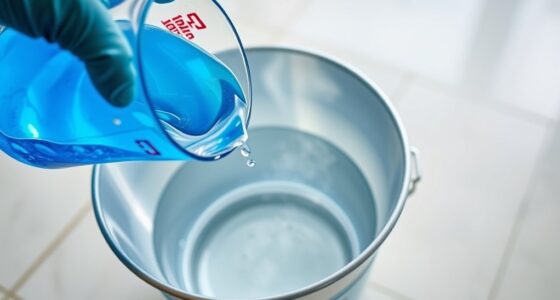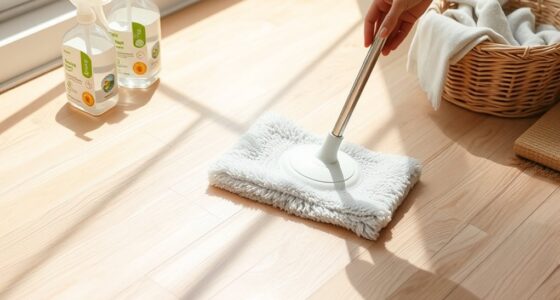For natural stone surfaces, a dry mop is best for quick, light cleaning and removing surface dust without moisture, helping maintain shine and prevent damage. Use a damp mop for more thorough cleaning, especially to lift dirt and stains, but guarantee you use minimal water and a stone-safe cleaner. The choice depends on how often and deeply you need to clean—continue to explore to discover the ideal approach for preserving your stone’s beauty.
Key Takeaways
- Use a dry mop for quick removal of loose dirt and dust on natural stone surfaces.
- Damp mopping with minimal moisture is better for regular cleaning and stain removal.
- Dry mops preserve sealant and prevent moisture buildup; damp mops support deep cleaning needs.
- Choose damp mopping for high-traffic areas or when grime and stains are present.
- Avoid over-wetting natural stone to prevent damage; select cleaning methods based on surface condition.

When it comes to cleaning natural stone surfaces, choosing between a dry or damp mop can substantially impact their appearance and longevity. How often you clean and whether you use a dry or damp method depends on the surface’s location, usage, and existing sealant. Regular cleaning frequency is essential to prevent dirt and debris from scratching or dulling the stone’s surface. For high-traffic areas like kitchen counters or entryways, you might need to clean more often—perhaps daily or every few days—while less-used surfaces can be maintained weekly.
Regular cleaning frequency depends on usage and location, from daily for high-traffic areas to weekly for less-used surfaces.
A dry mop is generally ideal for quick, light cleaning. It effectively picks up loose dirt, dust, and debris without adding moisture, which can be beneficial for surfaces with intact sealant layers. Dry mopping helps maintain the stone’s shine and prevents buildup of particles that could scratch the surface over time. However, over time, dirt and grime can settle into the stone if you don’t clean thoroughly enough, so a dry mop alone isn’t always sufficient for deeper cleaning.
Damp mopping, on the other hand, is better suited for regular, more extensive cleaning sessions. When you use a damp mop, you introduce just enough moisture to lift away grime and stains without overly saturating the stone. It’s essential to use a pH-neutral cleaner specifically designed for natural stone to avoid damaging the surface or compromising the sealant. Damp mopping also assists with sealant maintenance. Over time, sealants can wear down, allowing dirt and liquids to penetrate the stone. Using a damp mop with proper cleaning solutions helps preserve the sealant’s integrity, keeping your stone looking pristine and preventing staining.
Timing is key when it comes to sealant maintenance. If you notice dullness or loss of shine, it might be time to reseal the surface. Regular cleaning—whether dry or damp—helps extend the life of the sealant. For surfaces with a well-maintained sealant, a damp mop weekly or biweekly usually suffices, combined with occasional dry dusting in between. If your stone is unsealed or the sealant is aging, you may need to clean more gently or frequently, always paying attention to signs of wear or damage. Additionally, understanding the importance of using the right cleaning products can prevent damage—vetted products are recommended for natural stone surfaces to ensure safety and effectiveness.
Frequently Asked Questions
Can I Use Vinegar or Acidic Cleaners on Natural Stone?
You shouldn’t use vinegar or acidic cleaners on natural stone because they can etch and damage the surface. Instead, opt for pH-neutral cleaners and avoid acidic cleaners like vinegar or lemon juice. Baking soda is gentle enough for cleaning but should be diluted or used carefully to prevent scratching. Always test in a small area first, and stick to products formulated specifically for natural stone to keep it looking its best.
How Often Should I Dry Mop Versus Damp Mop?
You should dry mop your natural stone regularly, ideally daily, to remove loose dirt and debris, preventing scratches. Damp mop weekly or as part of your maintenance schedule to deep clean and remove stubborn grime. Adjust mopping frequency based on foot traffic; high-traffic areas may need more frequent damp mopping. Consistent dry and damp mopping help maintain the stone’s appearance and longevity, ensuring your surface stays beautiful and well-protected.
Is There a Specific Type of Cloth Best for Natural Stone?
Think of your natural stone as a delicate masterpiece that needs gentle touch. You’ll want to use microfiber cloths or soft cotton, like whispering secrets to your surfaces. These materials trap dirt without scratching or dulling the stone’s natural beauty. Avoid rough fabrics, which can be like sandpaper. With these gentle fabrics, you keep your stone shimmering and protected, turning cleaning into a soothing ritual rather than a chore.
Can Damp Mopping Cause Water Damage Over Time?
Damp mopping can cause water infiltration if you don’t dry the surface properly afterward, leading to long-term damage. Over time, excess moisture seeps into natural stone, weakening its structure and causing discoloration or cracks. To prevent this, use a damp cloth sparingly, guarantee thorough drying, and avoid leaving standing water. Proper maintenance helps preserve your stone’s beauty and integrity, avoiding costly repairs down the line.
Are There Natural Stone Types That Shouldn’t Be Damp Mopped?
Sure, some might say all natural stones are equally brave, but porous materials like unsealed travertine or limestone refuse damp mopping at all costs. These delicate surfaces love sealed surfaces for protection, but damp mopping can seep in and cause damage over time. So, if you have porous materials, stick to dry mopping or use a damp cloth carefully—your stone will thank you for it.
Conclusion
Choosing between a dry or damp mop for your natural stone is like finding the perfect rhythm in a dance—each step matters. When you opt for a damp mop, you gently cleanse without overwhelming your stone, much like a soft whisper. Use a dry mop for daily dust and debris, but always switch to damp when deeper cleaning is needed. With the right approach, your stone will shine like a star in the night sky, timeless and beautiful.









